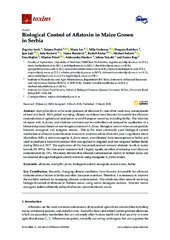| dc.creator | Savić, Zagorka | |
| dc.creator | Dudaš, Tatjana | |
| dc.creator | Loc, Marta | |
| dc.creator | Grahovac, Mila | |
| dc.creator | Budakov, Dragana | |
| dc.creator | Jajić, Igor | |
| dc.creator | Krstović, Saša | |
| dc.creator | Barošević, Tijana | |
| dc.creator | Krska, Rudolf | |
| dc.creator | Sulyok, Michael | |
| dc.creator | Stojšin, Vera | |
| dc.creator | Petreš, Mladen | |
| dc.creator | Stankov, Aleksandra | |
| dc.creator | Vukotić, Jelena | |
| dc.creator | Bagi, Ferenc | |
| dc.date.accessioned | 2024-03-13T11:36:40Z | |
| dc.date.available | 2024-03-13T11:36:40Z | |
| dc.date.issued | 2020 | |
| dc.identifier.issn | 2072-6651 | |
| dc.identifier.uri | http://fiver.ifvcns.rs/handle/123456789/4355 | |
| dc.description.abstract | Aspergillus flavus is the main producer of aflatoxin B1, one of the most toxic contaminants
of food and feed. With global warming, climate conditions have become favourable for aflatoxin
contamination of agricultural products in several European countries, including Serbia. The
infection of maize with A. flavus, and aflatoxin synthesis can be controlled and reduced by
application of a biocontrol product based on non‐toxigenic strains of A. flavus. Biological control
relies on competition between atoxigenic and toxigenic strains. This is the most commonly used
biological control mechanism of aflatoxin contamination in maize in countries where aflatoxins
pose a significant threat. Mytoolbox Af01, a native atoxigenic A. flavus strain, was obtained from
maize grown in Serbia and used to produce a biocontrol product that was applied in irrigated and
non‐irrigated Serbian fields during 2016 and 2017. The application of this biocontrol product
reduced aflatoxin levels in maize kernels (51–83%). The biocontrol treatment had a highly
significant effect of reducing total aflatoxin contamination by 73%. This study showed that
aflatoxin contamination control in Serbian maize can be achieved through biological control
methods using atoxigenic A. flavus strains. | sr |
| dc.language.iso | en | sr |
| dc.publisher | Basel : MDPI | sr |
| dc.relation | info:eu-repo/grantAgreement/EC/H2020/678012/EU// | sr |
| dc.relation | APV 114-451-2505/2016-01: Application of novel and conventional processes for removal of most common contaminants, mycotoxins and salmonella, in order to produce safe animal feed in the territory of AP Vojvodina, financed by the Provincial Secretariat for Higher Education and Scientific Research, AP Vojvodina | sr |
| dc.rights | openAccess | sr |
| dc.rights.uri | https://creativecommons.org/licenses/by/4.0/ | |
| dc.source | Toxins | sr |
| dc.subject | aflatoxin | sr |
| dc.subject | Aspergillus flavus | sr |
| dc.subject | biological control | sr |
| dc.subject | atoxigenic strain | sr |
| dc.subject | maize | sr |
| dc.subject | Serbia | sr |
| dc.title | Biological Control of Aflatoxin in Maize Grown in Serbia | sr |
| dc.type | article | sr |
| dc.rights.license | BY | sr |
| dc.citation.issue | 3 | |
| dc.citation.spage | 162 | |
| dc.citation.volume | 12 | |
| dc.identifier.doi | 10.3390/toxins12030162 | |
| dc.identifier.fulltext | http://fiver.ifvcns.rs/bitstream/id/11633/bitstream_11633.pdf | |
| dc.type.version | publishedVersion | sr |


